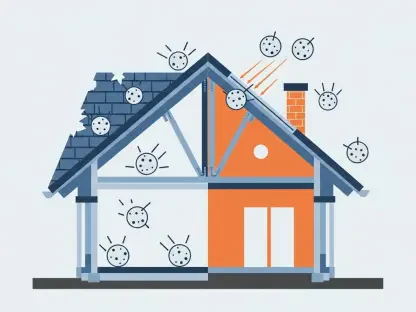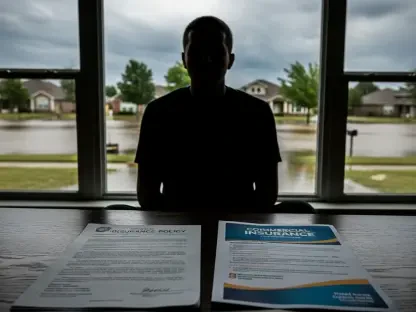As the climate crisis worsens, American households are facing the brunt of increasing insurance rates and growing difficulties in securing coverage. The escalating frequency and severity of natural disasters have resulted in significant financial losses for insurance companies, compelling them to raise premiums and reduce the availability of coverage. This situation is particularly dire for homeowners residing in areas identified as vulnerable to climate-driven natural disasters such as wildfires, hurricanes, and severe weather events. The mounting insurance costs and withdrawal of insurers from high-risk zones underscore the looming crisis both for the insurance industry and for the homeowners caught in its crosshairs.
Rising Insurance Costs
In Illinois, the effects of severe weather events have led to a notable rise in insurance premiums. Allstate, for instance, has increased its homeowners insurance rates by 14% this month, following a 12% increase last year. This trend is directly attributed to the surge in severe weather events impacting the state, which has caused substantial financial losses for insurance providers. The increase highlights the growing financial strain on both insurers and homeowners, with the latter finding it increasingly difficult to afford essential coverage.
Similarly, in California, the havoc caused by wildfires has pushed State Farm to request a rate increase of a staggering 22%. The company has already dealt with over 8,700 claims, disbursing more than $1 billion in payouts with expectations of additional losses. This rate hike is reportedly the most significant in the company’s history, reflecting the sheer magnitude of the burden climate-related disasters are placing on the insurance industry. As these severe events become more frequent and intense due to climate change, the financial pressures on insurance companies are only expected to escalate, leading to a continuous rise in premiums.
Withdrawal of Insurance Providers
One of the critical emerging trends is the proactive withdrawal of insurance companies from high-risk regions, leaving homeowners with limited options. This trend is epitomized by the story of Craig Kushen, a resident of Coto de Caza, California. Six years ago, his insurance company, Chubb, discontinued his coverage due to the heightened risk of wildfires in the area. This decision was made well before the recent fires that devastated Greater Los Angeles, underscoring the preemptive measures insurers are now taking to mitigate their risks.
Kushen’s experience mirrors a broader trend where insurance companies are retreating from areas perceived as too risky. This leaves homeowners, like Kushen, scrambling to find affordable coverage. After losing his Chubb policy, Kushen’s insurance costs surged from $4,000 to over $20,000 per year, forcing him to turn to the California Fair Access to Insurance Requirements (FAIR) Plan. The FAIR Plan provides insurance to those who are unable to secure coverage through traditional means, but it too is facing strain as costs continue to rise. Homeowners relying on the FAIR Plan are encountering higher rates, reflecting the ongoing struggle for adequate and affordable insurance coverage in high-risk areas.
Strain on the FAIR Plan
The FAIR Plan, designed as a last resort for Californians unable to find insurance, is also experiencing considerable pressure. Originally capping payouts at $1 million, the maximum amount has been raised to $3 million to account for rising home prices in California. Nevertheless, in a state renowned for its high property values, particularly in the San Francisco Bay Area, these limits remain insufficient for many homeowners, leaving them vulnerable to significant financial losses in the event of a disaster.
Despite its intentions, the FAIR Plan is a private association of insurance companies and not a public entity. As costs within the FAIR Plan rise, these expenses are ultimately passed on to consumers through higher rates. This creates a cycle where homeowners already grappling with high living expenses find themselves under an increasing financial burden due to soaring insurance premiums. The strain on the FAIR Plan mirrors the broader challenges faced by the insurance industry as it grapples with the growing impacts of climate change.
Economic Implications
As insurance companies endeavor to maintain profitability amid mounting climate-related claims, their strategies often involve substantial premium hikes and limiting the number of homes they are willing to insure. This approach places many homeowners in a precarious situation, having to choose between prohibitive insurance costs or no coverage at all. The lack of affordable insurance can severely impede homeowners’ ability to secure mortgages, complicating the path to homeownership and exacerbating economic inequality across affected regions.
The overarching consensus is that the insurance industry is facing an emerging crisis directly correlated with climate change. With the increasing prevalence and intensity of natural disasters—ranging from stronger hurricanes driven by warmer waters, heavier snowfalls, to unprecedented wildfires fueled by extreme drought—traditional insurance models are becoming unsustainable. The industry’s challenges reflect the broader societal risks and economic disruptions linked to the evolving climate crisis, further highlighting the urgent need for effective mitigation strategies.
Addressing the Root Cause
As the climate crisis intensifies, American households are grappling with the fallout of rising insurance rates and increasing difficulty in obtaining coverage. The growing frequency and severity of natural disasters such as wildfires, hurricanes, and severe weather events have inflicted substantial financial damage on insurance companies. Consequently, these firms are compelled to hike premiums and scale back the availability of coverage. This predicament is especially dire for homeowners in regions identified as high-risk due to climate-related threats. The escalating costs of insurance and the withdrawal of companies from vulnerable areas highlight a looming crisis for both the insurance industry and homeowners caught in its impact. These developments underscore the urgency of addressing the broader issue of climate change, as it directly affects financial stability for numerous American families. The interplay between climate change and rising insurance costs reveals an urgent need for solutions that can protect both insurers and homeowners in the face of a changing environment.









